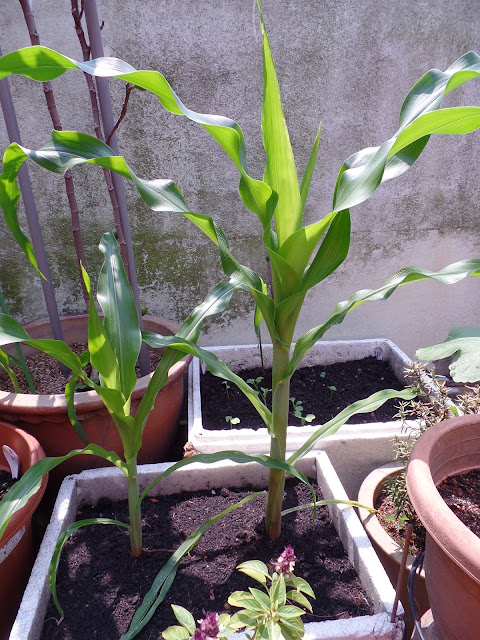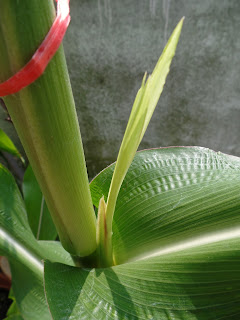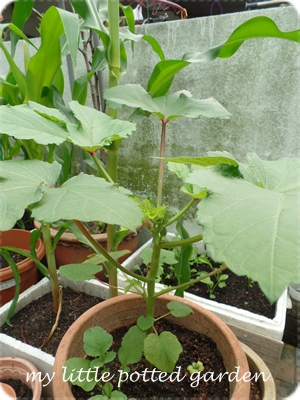This is the second variety of small cucumbers that I'm growing. The first one was Spacemaster Cucumber, which I have posted before, here.
The Mini Five Cucumber seed germinated on the 3rd day of sowing the seeds.
. Above seedling is three weeks old with true leaves, transplanted to a 12'" pot.
. Above seedling is three weeks old with true leaves, transplanted to a 12'" pot.
Slightly more than five week old seedling, it grows quite quickly. Prepare the stakes for support when the seedling is still small. I did not prepare enough stakes and have to further placed new stakes and do up the trellis when the plant is growing. Try to avoid that as it may disturb the growing roots.
During the growing period, watch out for cucumber beetles and squash bugs. (I have a squash plant next to the cucumber, but that will be a post for another day). They love squash and cucumber plants. I got rid of them by spraying neem oil spray solution. The solution would not kill them immediately, but it will leave them weaken and most of the time, they would not fly off immediately, so it will be easier to catch them when they are weaken. If they are left on the plant, they will feed on the leaves, make the plant weaker and eventually the plant will die. Also keep a look out for small tiny yellow eggs under the leaves. Get rid of them by spraying with organic spray.
I feed the plant with organic fertilizer which has a higher content of phosphorous and potassium for root growth and flower development. I also use a non-toxic fertilizer spray to encourage flowering and fruiting, as soon as the plant starts to flower, about once in every 10 days.
Most importantly, do not allow the plant to dry out. Growing them in pots, the soil will dry out quite fast in our hot humid blazing weather. I water the plant at least twice a day, sometimes three or four times, depending on the day's heat. The cucumber plant is rather fragile and the leaves would be wilting and sleeping on hot afternoons if exposed under the intense heat for many hours. So on most afternoons, I move the pot under shade (yes, tedious work, but worth it!). On one afternoon, I left the plant under the hot sun as I was not around that afternoon. When I came back, to my horror, found the plant with the leaves all "sleeping". Some of the leaves are already damaged by the hot scorching heat. I watered the plant immediately, watered again a few more times after that, and when the plant has "awaken", I cut off the dead leaves a few days later, already brittle by then. Took extra care of it since then, and now it seems to be doing OK.
Even though cucumber plants love the sun, our weather has been really hot lately, and it was just too much for it. Unlike bitter gourd plants which are more hardy and can withstand hot weather much better, the cucumber plant is more fragile to hot conditions. Best grow them in areas where they can get a few hours of morning sun, and shaded for the rest of the day. This is what I observed from my experience, and it might be different in the area where you live, depending on the temperature and climate.
Even though cucumber plants love the sun, our weather has been really hot lately, and it was just too much for it. Unlike bitter gourd plants which are more hardy and can withstand hot weather much better, the cucumber plant is more fragile to hot conditions. Best grow them in areas where they can get a few hours of morning sun, and shaded for the rest of the day. This is what I observed from my experience, and it might be different in the area where you live, depending on the temperature and climate.
The first plant : At two months from date of sowing the seeds.
This Mini Five Cucumber plant is a fast grower. Make a simple trellis with some bamboo stakes so that the tendrils of the plants have something to cling to for support. And you may need to help the plant along by steering the stems and tendrils along the support as the plant grows.
The plant starts to produce flowers at about 6 weeks old. Initially, only the male flowers appear, dozens of flowers! Male flower is attached to the stem at the base of the flower.
About a week later, the female flowers appear. Female flowers can be distinguished by the little cucumber attached to the flower. It needs the pollen from the male flower for pollination to occur so that the cucumbers can be fully formed. Otherwise the flowers will wilt and the small immature cucumber will simply turned yellow and eventually dried off. In my potted garden, there are some ants around, but not enough of bees to do the pollination job nature's way, so I have to do it manually by hand pollination, in order to get as many cucumbers as I can!
Lately, the flowers are not blooming as they should. There are dozens of female buds, both male and female, but for some reason or other, they do not go to full bloom. Could it be the reason being the weather is just too hot? Where I placed the pot at my front porch, it receives full direct sun, maybe it is just too hot, and it is stressful for the plant? On the other hand, my second plant, which I placed at my back yard is enjoying the sun in the morning for about 2-3 hours or so, and is shaded the rest of the day. This plant is doing much better, it is half the size of the first plant and the flowers are blooming so nicely, which makes pollinating work so much easier. For the first plant, I have to gently tear open the petals of the unopened female flower (making sure that it is mature enough to be pollinated before doing that) to expose the stigma, and I plucked one full bloomed male flower from my second plant, gently remove all the petals, and rub the stamen (where the pollen produces) gently onto the stigma of the female flower. The flowers are very fragile, so handle them gently. I should be getting more cucumbers from the first plant if not for these reasons. Some of the pollinations done are not successful. But I'm expecting more cucumbers from my second plant, which appears to be doing fine.
These two pictures are spaced only by a difference of three days. The first picture shows the cucumber is forming along very nicely, about 4-5 days after pollination. Once the pollination occurs successfully, the cucumber will start to form it's fruit and it grows quite fast after that. Makes me happy each day looking at the cucumbers! The second picture was taken on harvest day, about 7 days from date of pollination.
The second cucumber. This was harvested a day later than the one above.
Mini Five Cucumbers are mini cucumbers, as the name implies. They can be harvested when they have grown to about 4" to 5" in length or even smaller if preferred. These two cucumbers were harvested at about 8-1/2 weeks from date of sowing the seeds. Sizes for these two, one is about 4-1/2" and the other almost 5".
There's not much seeds insides which makes them really great for eating raw. These mini cucumbers are juicy, crisp and succulent! You don't have to peel them. Growing your own without the use of any pesticides, you will be happy to serve your family such healthy fresh produce from your own garden.
Cucumber, Onion and Mint Salad.
The second Mini Five Cucumber plant of which I've sowed the seeds about 10 days later than the plant above, is blooming with lots of both male and female flowers right now. I have pollinated a few flowers the last two days (five to be exact), and looking forward to more mini cucumber harvest in the next week or so, hopefully! Planning to grow more of these Mini Five Cucumber plants, I really like this variety, the cucumbers are excellent for eating raw.
If you have not tried growing Mini Five Cucumbers before, you should give it a go! They do not need much space, great for growing in pots and containers. What you will need is a medium to large pot, some stakes for support and your TLC! When you harvest your first cucumbers, you would be smiling, like I did! Now that I have tried growing two varieties of mini cucumbers, I'm looking into growing the bigger ones.
In case you are wondering where I got the seeds from, I bought these Mini Five Cucumber Seeds from :My Lestary Seeds
Happy Gardening !





















































